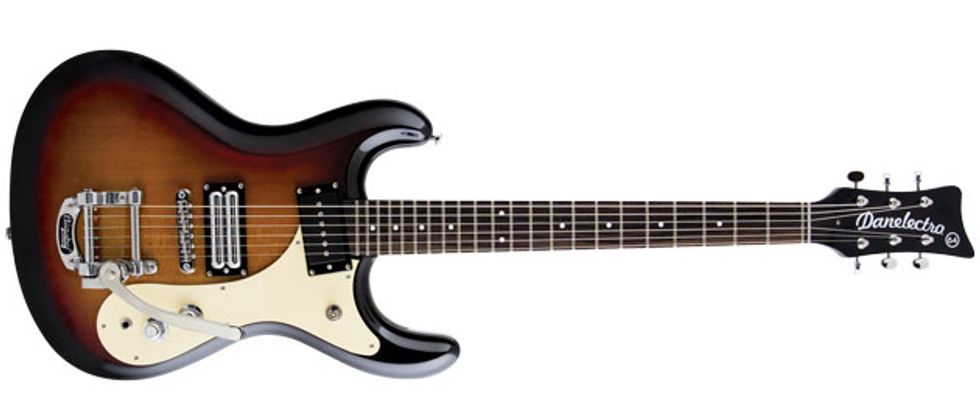The original Mosrite Ventures model is one of the prettiest solidbody shapes ever. And in the years since Danelectro’s revival in the ’90s, the company has paid homage to Semie Moseley’s masterpiece more than once. Dano’s first riffs on the Mosrite shape were cool and functionally distinctive guitars. The Hodad line, which often came in spectacular sparkle finishes, featured 6- and 12-string versions and cool pickup switching options. The cheaper Innuendo bristled with Vox-like, push button effects.
Danelectro’s Korea-built ’64, however, largely dispenses with the idea of melding “Mosrite-ness” and “Danelectro-ness,” favoring a much more literal re-interpretation of Moseley’s ’60s designs. The result is a fun-to-play, uniquely expressive guitar that can range from scuzzy to smooth.
Give My Regards to Bakersfield
Clearly, a lot of thought went into the outward authenticity of the ’64, and little touches like the zero fret, chrome knobs, and German-carve top are cool nods to the products that came out of Moseley’s Bakersfield, California, shop in the ’60s. Mosrite’s Vibramute vibrato would have been prohibitively expensive to replicate, and is replaced here by a Bigsby unit. It’s a great stand-in, though it lacks some of the odd elasticity and longer arm length of the old Mosrite arms. Roller saddles on the bridge make using the Bigsby a lot more satisfying in terms of tuning stability, feel, and nuance. Other deviations from Mosrite norms will insulate younger players from the original line’s more polarizing idiosyncrasies. The neck is much more substantial in width and profile than the notoriously slim Mosrite necks of the ’60s. The medium frets are also taller. The Danelectro feels a little more generic as a consequence, but few modern players who know better are likely to complain.
Given how Danelectro strived for accuracy on so many counts, some aesthetic features are a bit curious. The cool, original Danelectro logo, which is both closer in spirit to the original Mosrite logo and just looks flat-out hip, is replaced by a large-script logo. Weirder still is the choice of the twin-lipstick-tube humbucker—a throwback to the Hodad that gives the ’64 an air of parts-bin mutant design and upsets the well-balanced lines and more authentic touches.
Ratings
Pros:
Lots of authentic Mosrite styling. Coil-tap humbucker lends versatility.
Cons:
Humbucker sounds can be excessively mid-focused.
Tones:
Playability:
Build/Design:
Value:
Street:
$799
Danelectro ’64
danelectro.com
Aesthetics aside, the ’64 is put together well. The fretwork is clean. The finish is lovely. The hardware, from the Kluson-style tuners to the switches, has a solid, reliable feel that inspires confidence. A lot of otherwise sound Asia-built guitars we see cut corners on this count, rendering otherwise nice instruments less adaptable to the rigors of travel and stage life. It’s nice to see Danelectro deliver. The ’64’s one shortcoming, as I received it, is a setup that left the action uncomfortably high—especially given that the zero nut tends to enable slinky, low action for those who prefer it.
Ventures Are Go!
The ’64’s stylish curves give the guitar an elongated look, but the instrument feels balanced. It’s definitely more evenly weighted than the Hodad and Innuendo, which, with their semi-hollow construction, were prone to neck dive. With the Bigsby’s arm swung out of the way, the ’64’s volume control is perfectly situated for swells, though it can trip up tone-knob adjustments.
Sonically speaking, the Danelectro ’64 delivers the spirit of an original Mosrite more than it fastidiously replicates the sound of one. The sum of the Danelectro’s parts makes a range of sounds that can cover mellifluous surf tones and Johnny Ramone’s churning, raw power alike. Mellow, glowing surf and soul tones are available from the neck single-coil, which looks a little like a P-90 and lands sonically somewhere between a P-90 and a Jazzmaster neck pickup. It generates very pretty clean tones, which were my favorite sounds from the instrument. Single-coil bridge sounds are available by pulling up the tone knob and splitting the coil of the bridge humbucker. This configuration sounds more akin to a hottish Stratocaster pickup, although it lacks some of a Strat pickup’s bell-like qualities.
The full humbucking sound of the bridge pickup is, of course, the most significant deviation from classic Mosrite tones (and ’60s tones in general). Although not screamingly loud, it sounds and feels hot, with a focus in the mid and high-mid range that can make the tone feel a bit thin relative to its volume. In lead contexts it works pretty well—especially with a boost or overdrive that let’s you scoop a little midrange. And it’s punky, brash side makes this a great candidate for players chasing punk and hardcore sounds. Mellower applications, like folk-rock arpeggios, reveal more of the relative narrowness in the frequency spectrum.
The Verdict
For all its visual authenticity and attention to detail, Danelectro’s ’64 is not supposed to be a Mosrite replica (even if, in some places on the company’s website, they call it a “reissue”). It is, however, a versatile rock machine with a very extroverted style and sonic personality that will entice players tired of the same old solidbody designs. There’s room for improvement. I can imagine a sonic (and perhaps visual) payoff in switching out the lipstick humbucker for a PAF or some other wide-frequency, lower output, smoother-sounding humbucker. And while the guitar is well put together, the near-$800 price tag feels steep for an instrument that doesn’t even come with a soft case and features a less than spectacular bridge pickup. But you cannot deny the ’64’s visual appeal, attention to stylin’ detail, and high-quality build. If you’re on the prowl for a solidbody alternative, it’s hard to not be tempted by an accessibly priced instrument with this much potential.















![Rig Rundown: Russian Circles’ Mike Sullivan [2025]](https://www.premierguitar.com/media-library/youtube.jpg?id=62303631&width=1245&height=700&quality=70&coordinates=0%2C0%2C0%2C0)









